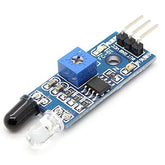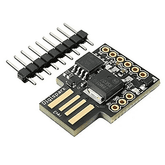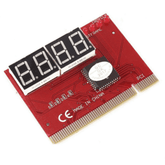Proximity Sensor Types
Summary
Are you curious about proximity sensors? If the answer is Yes! then this blog has got you covered! we explore the different types of proximity sensors, such as inductive, capacitive, and ultrasonic sensors, and their uses in various industries. Additionally, we provide a comparison table to help readers understand the differences between each sensor type. Whether you're an engineer or just interested in the technology behind these sensors, this blog is a must-read!
Introduction
Proximity sensors are an important part of automation and robotics. They detect objects or signals without any contact between them, which eliminates the need for physical contact with a machine or object being sensed. Proximity sensors come in various shapes and sizes, depending on their application. Common types of proximity sensors include infrared (IR) proximity sensors, ultrasonic proximity detectors as well as capacitive field effect transistors (C-FETs).
IR sensing is predominantly employed to measure distances whereas ultrasonic devices function more effectively when used over large areas due to the noncontact mode of operation achieved by sending out sound waves that bounce off nearby surfaces enabling the detection of near-distance objects accurately at long ranges even through obstacles like walls and water droplets among other things. C-FET-based solutions offer higher sensitivity compared to optics-driven techniques while displaying better performance characteristics such as light immunity under low cost making it apt for demanding industrial applications where accuracy is a paramount requirement along with reliability,
What is a Proximity Sensor?
The proximity sensor is a device used to detect nearby objects. When the object comes into its sensing area an electrical signal gets generated and this helps to detect the object.
Read our blog about how does a proximity sensor work
Types of Proximity Sensors and Their Uses
Proximity sensors are used in many applications to detect objects without physical contact. They can measure the distance, presence, speed, and direction of an object relative to the sensor itself. There are different proximity sensor types such as ultrasonic ones which emit high-frequency sound waves that bounce off a target surface; capacitive ones with two conductive plates forming a capacitor; inductive magnetostrictive ones using magnetic fields generated by current flow through coil windings or permanent magnets; photoelectric devices relying on principles involving light sources like infrared beams which activate output when penetrated by an obstacle and active optical systems utilizing laser technology for sensing objects within its line-of-sight range. For precise application requirements you must select the right type based on your needs so be sure to study each one thoroughly!
Based on the non-contact object detection method, there are five proximity sensor types. such as,
- Capacitive Proximity Sensor.
- Inductive Proximity Sensor.
- Magnetic Proximity Sensor.
- Optical Proximity Sensor.
- Ultrasonic proximity Sensor.
Let's, discuss these five proximity sensor types and working principles.
1. Capacitive Proximity Sensor

capacitive proximity sensor types work on the principle of varying capacitance. So, as the capacitance changes corresponding output signal generated also changes. This capacitance change is marked by the shape of the object and the distance of the object from the sensor.

The sensor consists of an oscillator, trigger circuit, and output switching device. As the target enters the electric field generated by the sensor, the electric field generated gets obstructed by the target resulting in a change in capacitance which results in a change in amplitude of the oscillator circuit. When the target moves further from the sensor the amplitude of oscillation decreases and when the target comes close amplitude increases. This change triggers the trigger circuit resulting in a change in the output of the sensor and thus glowing the output sensor led.

Application
As shown in the above image they can be used to detect objects on the conveyor belt.
2. Inductive Proximity Sensor
Inductive Proximity Sensor types work on two principles
Faraday's Law of induction
When an electrical conductor is placed in a magnetic field, eddy currents are produced in the conductor.
Lenz’s Law

These eddy currents generate a magnetic field that opposes the cause or the magnetic field that generated it.
This type of sensor has a wire wound around typically an iron core. As shown in the above figure, an alternating current is applied to the coil which generates a magnetic field around it. This magnetic field gives rise to an eddy current in the electrical conductor. These eddy currents then generate an eddy current magnetic field that opposes the electromagnetic field from the sensor. When the target is taken close to the sensor the electromagnetic field from the sensor gets reduced, which decreases the amplitude of the electromagnetic field. When it decreases beyond the threshold trigger circuit activates the output. This helps to identify that the object has come into the desired vicinity of the sensor.
Note: It has a similar internal circuit as that of the capacitor sensor.

Refer to this guide for interfacing proximity sensor with Arduino to get a hands-on experience with this sensor.
3. Magnetic Proximity Sensor

This type of proximity sensor works on the principle of the Hall effect. As shown in the figure, a potential voltage is applied across a hall element such as a hall element made of tin. So positive and negative charges start flowing. Now, when a magnet is brought into the vicinity of the hall element material, negative and positive charges get
accumulated across the opposite ends of the plate. When we measure the voltage across it a tiny voltage in microvolts is obtained. This is usually amplified by an amplifier. When the object is taken closer a higher potential gets generated across the plates and when it exceeds the threshold output is set to high. There are various other technologies too used in magnetic proximity sensors such as variable reluctance, reed switches, GMR (Giant Magneto-Resistive effect) inductive
4. Optical Proximity Sensor

Optical proximity sensor types consist of a transmitter and a receiver. The transmitter circuit consists of a photo transmitter that sends light out by converting electrical energy into light. This light gets bounced back from the target which is received by the photo receiver. There are three types of optical proximity sensors: through-beam sensor, retro-reflective sensor, and diffuser sensor.
5. Ultrasonic Proximity Sensor

An ultrasonic proximity sensor consists of a transmitter and receiver. As shown transmitter sends out a sound wave and the receiver detects the reflected wave from the object. You can refer to this guide Arduino Interfacing with an ultrasonic sensor if you want to try something hands-on.
Visit our Proximity Sensors page for accurate reading Sensors.
Comparison Table of Proximity Sensors
|
Parameter |
Capacitive Proximity Sensor |
Inductive Proximity Sensor |
Magnetic Proximity Sensor |
Optical Proximity Sensor |
Ultrasonic Proximity Sensor |
| Sensing distance (mm) | 1-35mm (some sensors up to 70mm) | Up to 60 mm | Up to 80 mm | 2-30mm | Up to 1000mm |
|
Vibration tolerant |
Excellent | Excellent | Excellent | Excellent | Poor |
| Sensitivity | Very sensitive to changes in environmental conditions such as temperature and humidity. | Adaptable to harsh environments | Susceptible to magnetic interference | Sensitive to dust and lubricants | Temperature variations( since the speed of sound is dependent on temperature |
| Sensing object material | The object can be made up of any material | Ferrous metals such as iron and steel. Non-ferrous metals sensing range decreases(will be given in datasheet) |
The object should be of Magnetic material only. | The object can be made up of any material. ( fails for a transparent object ) | The object can be made up of any material. ( works for transparent objects) |
| Cost | Medium | Low | Low | Medium | High |
| Size | small | small | small | small | small |
| Application | They are used for detecting parts in conveyors, workstations, and robots. | Foil seal detection inside plastic caps, to count metal cans. | Used to detect the open or closed status of windows, gates, and doors. Used in the food industry. |
Automatic soap dispenser, optical heart rate monitor, optical liquid level indicator. | Liquid level control, robotic sensing, counting people, automobile self-parking technology, and anti-collision safety systems. |
Conclusion
In this blog post, we have learned that proximity sensors are vital components in various industries, from automotive to manufacturing. They are designed to detect the presence or absence of objects, making them indispensable for automation and control applications. With different types of proximity sensors available, each with its unique features and uses, it's essential to choose the right one for your specific application. We hope that our comparison table of proximity sensors and detailed explanation of their types and uses has provided valuable insights and helped you make an informed decision. Whether you're looking to improve efficiency, reduce downtime, or enhance safety, proximity sensors can make a significant difference in your operations. So, choose wisely and enjoy the benefits of proximity sensors today!
If you appreciate our work don't forget to share this post and leave your opinion in the comment box.
Please do check out other blog posts about Popular electronics
Check out other related blog post about sensors : Types of Sensors in IoT , Interfacing Proximity Sensors with Arduino and How proximity sensor works
Make sure you check out our wide range of products and collections (we offer some exciting deals!)










